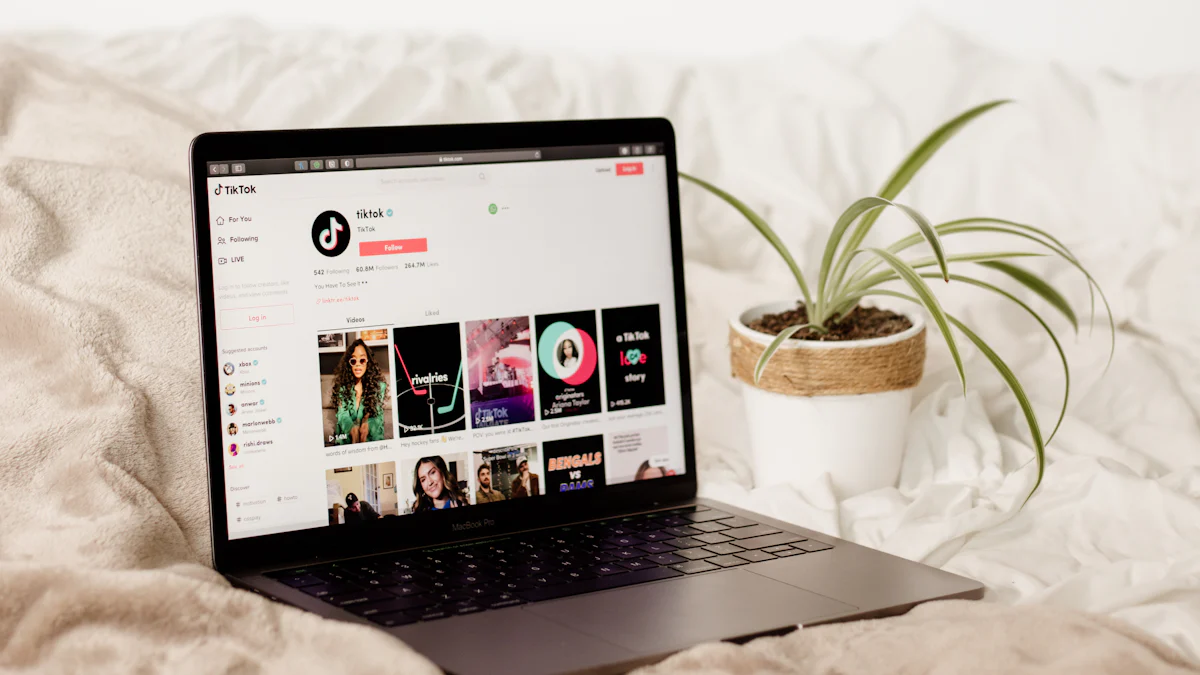Global Influencer Marketing Market Growth Trends and Insights

Influencer marketing has transformed the global digital economy. It has grown from a $1.7 billion industry in 2016 to a staggering $21.1 billion in 2023. This rapid expansion highlights its effectiveness in connecting brands with audiences. You see brands increasingly turning to influencers because they build trust and boost engagement. Campaigns with influencers often achieve higher conversion rates, making them a preferred strategy for businesses.
The global influencer marketing market thrives on authenticity. Influencers curate loyal followings that value their opinions, amplifying brand awareness. Industries like fashion influencer marketing have particularly benefited, as influencers showcase products in relatable ways. This approach resonates with consumers, driving growth and innovation in the market.
What is Influencer Marketing and Why Does It Matter?
Definition of Influencer Marketing
Influencer marketing is a social media strategy where influencers promote products or services through platforms like Instagram and YouTube. These influencers are trusted figures within niche communities, known for their expertise or large followings. You’ll find that influencer marketing thrives on relationships between brands and influencers. By leveraging their credibility, influencers create authentic content that resonates with their audience.
The Global Impact of Influencer Marketing
The global influencer marketing market has reshaped how businesses connect with consumers. Companies like Nike have partnered with micro-influencers to showcase products in real-world settings, driving authentic engagement and boosting sales. L'Oréal has taken innovation further by using virtual influencers like Miquela, creating hyper-realistic content that captivates audiences. Coca-Cola’s regional campaigns demonstrate how tailoring influencer strategies to local cultures enhances brand loyalty. These examples highlight how influencer marketing transcends borders, making it a cornerstone of the global digital economy.
Key Benefits for Brands and Businesses
Influencer marketing offers several advantages for your business. First, it increases brand awareness by exposing your products to new audiences. Influencers’ loyal followers trust their recommendations, which builds authenticity and strengthens your brand’s credibility. You’ll also notice higher engagement rates with influencer campaigns compared to traditional advertising. Collaborating with micro-influencers can be a cost-effective way to achieve these results. Additionally, influencers often adopt new social media trends early, helping your brand stay relevant in a fast-changing market.
The global influencer marketing market continues to grow because it delivers measurable results. Whether you’re in fashion influencer marketing or another industry, this strategy helps you connect with consumers in meaningful ways.
Global Influencer Marketing Market Size and Growth

Current Market Size
The influencer marketing market has experienced remarkable growth in recent years. In 2023, the influencer market size was valued at $13.86 billion, showcasing its rapid expansion. This figure represents more than triple the market size recorded in 2019. By 2024, the global influencer marketing market is expected to reach $24 billion, reflecting its increasing importance in the digital economy.
The United States plays a significant role in this growth. In 2023, U.S. businesses spent approximately $26.09 billion on influencer marketing campaigns. This spending accounted for a substantial portion of the global total, which exceeded $34 billion. These numbers highlight the growing reliance on influencer marketing as a key strategy for businesses worldwide.
Projected Growth and Future Outlook
The future of the influencer marketing market looks promising. Experts project that the market will grow from $18.49 billion in 2024 to an astounding $185.43 billion by 2032. This growth represents a compound annual growth rate (CAGR) of 33.4%, making it one of the fastest-growing sectors in the digital marketing industry.
A closer look at the influencer marketing statistics reveals a steady upward trend. For instance, the market size in 2018 was $4.6 billion. By 2023, it had grown to $21.1 billion, demonstrating its consistent expansion. This trajectory indicates that influencer marketing will continue to dominate the advertising landscape in the coming years.
| Year | Market Size (USD) | CAGR (%) | |------|-------------------|----------| | 2019 | 10.39 billion | - | | 2023 | 13.86 billion | - | | 2031 | 139 billion | 33.4 |
Key Statistics and Data Points
Several influencer marketing statistics underscore the market's growth and potential:
- Over 70% of marketers believe influencer marketing effectively increases brand awareness.
- The global influencer marketing value tripled between 2019 and 2023, reaching $24 billion.
- The fashion influencer marketing market size has significantly contributed to this growth, with brands leveraging influencers to drive engagement.
- In 2023, the influencer marketing industry was worth $21.1 billion, up from $13.8 billion in 2021.
These statistics highlight the growing reliance on influencer marketing across industries. Whether you focus on fashion influencer marketing or other sectors, the data confirms its effectiveness in driving results.
Key Drivers, Restraints, and Opportunities
Drivers of Market Growth
Increasing Social Media Usage
The influencer marketing market thrives on the widespread use of social media platforms. You see platforms like Instagram, TikTok, and YouTube growing rapidly, with billions of active users worldwide. This growth creates a fertile ground for influencer marketing campaigns. People spend more time on these platforms, engaging with content and discovering new products. The rise of smartphones and improved internet access has further fueled this trend. As more users join social media, brands can connect with larger audiences through influencer relationship management.
Rising Demand for Authentic Content
Consumers today value authenticity. They trust influencers who share genuine experiences and relatable stories. This demand for authentic content drives the global influencer marketing market. Influencers showcase products in real-life scenarios, making them more appealing to their followers. For example, fashion influencer marketing campaigns often feature influencers wearing and styling products, which resonates with audiences. This approach builds trust and enhances the effectiveness of influencer marketing campaigns.
Restraints and Challenges
Issues with ROI Measurement
Measuring the return on investment (ROI) remains a significant challenge in influencer marketing. About 60% of marketers struggle to track the effectiveness of their campaigns. You might find it difficult to determine how much revenue a specific influencer generates for your brand. This lack of clarity can make it harder to allocate budgets effectively.
Concerns Around Fake Followers and Fraud
Fake followers and fraudulent activities pose another challenge. Studies show that one in four influencers has purchased fake followers. Additionally, 9.5% of Instagram accounts are bots. Identifying these fake accounts can be a daunting task for marketers. This issue affects the credibility of influencer marketing campaigns and can lead to wasted resources.
Opportunities for Growth
Expansion into Emerging Markets
Emerging markets present significant opportunities for the influencer marketing market. Social media adoption is rising in regions like Asia-Pacific, Latin America, and Africa. You can tap into these markets to reach new audiences and drive growth. Consumers in these regions trust influencers, making campaigns more impactful. Targeting niche markets within these areas allows for tailored strategies that resonate with local audiences.
Integration of AI and Data Analytics
Artificial intelligence (AI) and data analytics are transforming influencer relationship management. AI-powered tools help you identify the right influencers for your campaigns. These tools analyze data to predict campaign outcomes, improving ROI. Data analytics also provides insights into audience behavior, enabling you to create more effective strategies. By leveraging these technologies, you can stay ahead in the competitive global influencer marketing market.
Market Segmentation Analysis
By Application
Brand Awareness Campaigns
You can use influencer marketing to boost brand awareness effectively. Influencers create relatable content that resonates with their audience, helping your brand reach new customers. Social media takeovers are a popular method. Influencers temporarily manage a brand’s account, introducing your products to their followers. Unboxing videos also generate excitement. These videos showcase your products in an authentic way, leading to high engagement rates. Tutorials and product reviews refresh your content strategy while engaging your target audience.
Brands like LIMITLESS have successfully used influencer marketing to connect with health-conscious individuals. This approach increased their social media engagement and drove direct sales. Similarly, COOLA partnered with over 500 influencers, achieving a 60% sales increase. Aura Frames scaled its influencer program, generating over 2.5 million impressions through personalized content. These examples highlight how influencer marketing can elevate your brand awareness campaigns.
Product Launches and Promotions
Influencer marketing plays a crucial role in product launches and promotions. By partnering with influencers, you can leverage their credibility to introduce your products to a wider audience. This strategy relies on social proof, making it more authentic than traditional advertising. For example, KFC collaborated with designer Katie Eary to promote their Ricebox. This campaign combined fast food with fashion, creating intrigue and excitement around the product.
You can also engage influencers to create unique content or design packaging for your product launches. This approach not only educates their audience about your product but also builds anticipation. Influencer marketing ensures your promotions stand out in a crowded market.
By End-Users
Small and Medium-Sized Enterprises (SMEs)
SMEs benefit from influencer marketing by collaborating with nano and micro-influencers. These influencers offer cost-effective visibility, with posts ranging from $500 to $8,000. Their highly engaged audiences help you build trust and credibility. Local influencers allow you to target specific geographic areas, making your campaigns more effective. SMEs also use influencers to connect with niche audiences, ensuring your products reach the right customers.
Large Corporations
Large corporations often work with celebrity influencers to amplify their campaigns. While these partnerships can cost up to $45,000 per post, they provide extensive reach. Corporations also use influencer marketing to maintain their relevance in the digital space. By collaborating with influencers across various platforms, you can ensure your brand stays visible to a global audience.
By Region
North America
North America leads the influencer marketing market. The United States accounts for a significant portion of global spending, with brands investing heavily in influencer campaigns.
Europe
Europe has seen steady growth in influencer marketing. Countries like the UK and Germany are key players, with brands focusing on fashion influencer marketing to engage audiences.
Asia-Pacific
Asia-Pacific offers immense potential for influencer marketing. The region’s growing social media adoption makes it a fertile ground for campaigns. Fashion influencer marketing is particularly popular here, with influencers driving trends and consumer behavior.
Latin America
Latin America is an emerging market for influencer marketing. Brands are leveraging local influencers to connect with culturally diverse audiences.
Middle East and Africa
The Middle East and Africa are experiencing a rise in influencer marketing. Social media platforms are gaining traction, providing opportunities for brands to expand their reach.
Emerging Trends in Influencer Marketing

The Rise of Micro-Influencers
Micro-influencers are reshaping the influencer marketing market. These individuals, with audiences ranging from 1,000 to 10,000 followers, offer a unique advantage. Their smaller but highly engaged communities trust their recommendations, making them ideal for authentic brand partnerships. You’ll find that micro-influencers often deliver higher engagement rates compared to larger influencers. This makes them a cost-effective choice for businesses, especially in fashion influencer marketing.
Brands increasingly prefer micro-influencers because they create genuine connections with their followers. Their relatability fosters trust, which translates into better campaign results. As the influencer marketing market evolves, micro-influencers will continue to play a pivotal role in driving engagement and authenticity.
Growth of Video Content and Live Streaming
Video content dominates the influencer marketing market. Platforms like TikTok, Instagram Reels, and YouTube have made short-form videos a powerful tool for influencers. These videos capture attention quickly and deliver messages effectively. You’ll notice that influencers are focusing more on video strategies to align with consumer preferences.
“Content is progressing, and video is central to this growth. Artificial Intelligence is now lending a hand with editing, letting creators shift focus from technicalities to creativity,” notes Carlos Medina, Futurist and Tech Analyst from Austin.
Live streaming is another trend gaining traction. Shoppable live streams combine entertainment with e-commerce, allowing consumers to make purchases during live sessions. This format creates an interactive shopping experience, making it a valuable addition to influencer marketing campaigns.
Technological Advancements in Influencer Marketing
AI-Powered Influencer Platforms
Artificial intelligence is revolutionizing the influencer marketing market. AI tools automate tasks like influencer discovery and campaign management, saving you time and effort. These platforms analyze large datasets to identify the most relevant influencers for your brand. AI also enhances content creation by suggesting optimal posting times and generating personalized captions.
Virtual influencers, powered by AI, are another innovation. These computer-generated characters simulate human behavior and engage with audiences. They offer brands a unique way to target specific niches, making them a versatile option for campaigns.
Blockchain for Transparency and Trust
Blockchain technology is addressing trust issues in influencer marketing. Smart contracts automate payments, ensuring influencers receive compensation once they meet agreed terms. This eliminates delays and builds trust between brands and influencers.
Blockchain also promotes transparency. It records sponsorships on an open ledger, allowing audiences to see when influencers are compensated. This openness fosters credibility and reduces misinformation. By verifying claims made by influencers, blockchain ensures that promotions are backed by reliable data.
Increasing Focus on Niche Audiences
Focusing on niche audiences has become a powerful strategy in the influencer marketing market. Niche influencers specialize in connecting with specific groups of people who share unique interests or needs. Their deep understanding of these communities allows them to create content that feels personal and relatable. This approach leads to higher engagement and builds trust between your brand and its audience.
When you partner with niche influencers, you can target specific consumer segments more effectively. These influencers already have established relationships with their followers, making it easier for your brand to connect authentically. For example, in fashion influencer marketing, niche influencers often cater to particular styles or trends. Their followers trust their recommendations, which can drive meaningful engagement and increase your campaign’s success.
Niche audiences also offer a cost-effective way to maximize your marketing efforts. By collaborating with influencers who have cultivated these audiences, you save time and resources. Instead of casting a wide net, you focus on a smaller, more engaged group of potential customers. This targeted approach ensures that your message reaches the right people, increasing the likelihood of conversions.
The influencer marketing market thrives on authenticity, and niche influencers excel in this area. Their content resonates deeply with their followers, creating a sense of community and loyalty. Whether you’re exploring fashion influencer marketing or other industries, tapping into niche audiences can help your brand stand out. By prioritizing these focused campaigns, you can build stronger connections and achieve better results.
The influencer marketing market has shown remarkable growth and potential. It continues to evolve as a powerful tool for businesses to connect with audiences authentically. You can leverage this strategy to boost brand visibility, drive engagement, and achieve measurable results.
To succeed in this dynamic market, consider these key takeaways:
- Use micro-influencers for better engagement and celebrity influencers for broader reach.
- Build long-term partnerships with influencers to maintain credibility.
- Stay aligned with trends like video content and data-driven strategies.
Emerging technologies also play a vital role. AI simplifies influencer selection and performance tracking. Blockchain ensures transparency in transactions. Interactive content, such as polls, enhances engagement, while AR and VR create immersive brand experiences. By staying informed, you can adapt to these advancements and maximize your campaigns' impact.
The influencer marketing market thrives on innovation. Whether you focus on fashion influencer marketing or other niches, staying ahead of trends ensures your brand remains competitive.
FAQ
What is the difference between micro-influencers and macro-influencers?
Micro-influencers have smaller audiences (1,000–10,000 followers) but higher engagement rates. Macro-influencers, with larger followings (100,000+), offer broader reach. You should choose micro-influencers for niche campaigns and macro-influencers for brand awareness.
How can you measure the success of an influencer marketing campaign?
Track metrics like engagement rate, website traffic, and sales conversions. Use tools like Google Analytics or influencer platforms to analyze performance. Focus on ROI to evaluate the campaign’s effectiveness.
Are nano-influencers effective for small businesses?
Yes, nano-influencers (fewer than 1,000 followers) are cost-effective and highly relatable. Their close-knit communities trust their recommendations. You can use them to target local or niche audiences.
How do you avoid fake followers in influencer marketing?
Use tools like HypeAuditor or Social Blade to analyze influencer profiles. Look for consistent engagement rates and authentic comments. Avoid influencers with sudden spikes in followers.
Why is video content important in influencer marketing?
Video content grabs attention quickly and delivers messages effectively. Platforms like TikTok and Instagram Reels make videos engaging. You can use videos to showcase products, share tutorials, or host live streams for interactive shopping experiences.
Tip: Always align your influencer strategy with your brand goals to maximize results.
See Also
Key Influencer Marketing Trends You Should Follow in 2024
Decoding the Return on Investment in Influencer Marketing
Essential Influencer Marketing Statistics Every Marketer Should Know
15 Must-Have Influencer Marketing Platforms for 2024
Best Influencer Marketing Platforms to Boost E-commerce Growth
